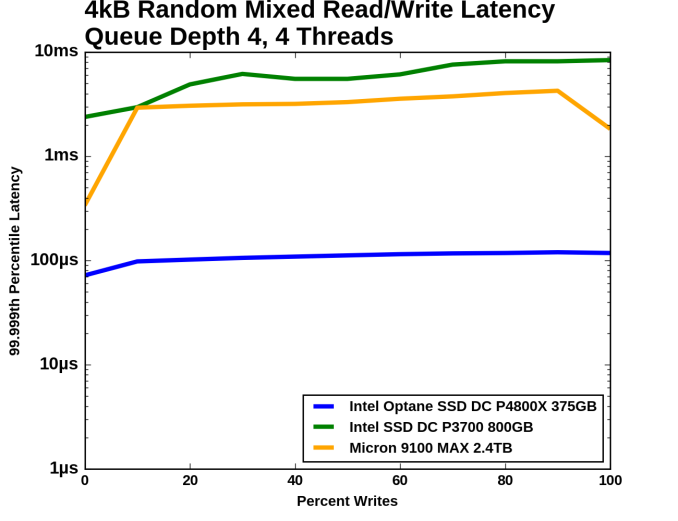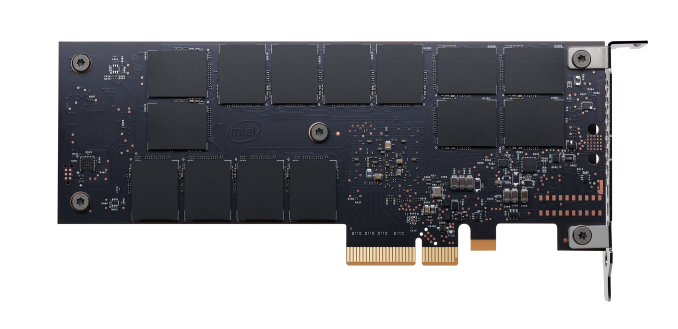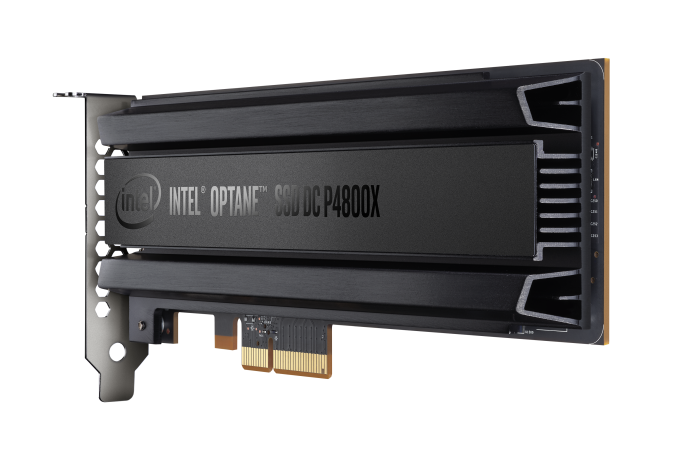The Intel Optane SSD DC P4800X (375GB) Review: Testing 3D XPoint Performance
by Billy Tallis on April 20, 2017 12:00 PM ESTFinal Words: Is 3D XPoint Ready?
The Intel Optane SSD DC P4800X is a very high-performing enterprise SSD, but more importantly it is the first shipping product using Intel's 3D XPoint memory technology. After a year and a half of talking up 3D XPoint, Intel has finally shipped something. The P4800X proves that 3D XPoint memory is real and that it really works. The P4800X is just a first-generation product, but it's more than sufficient to establish 3D XPoint memory as a serious contender in the storage market.
If your workload matches its strengths, the P4800X offers performance that cannot currently be provided by any other storage product. This means high throughput random access, as well as very strict latency requirements - the results Optane achieves for it's quality of service for latency on both reads and writes, especially in heavy environments with a mixed read/write workload, is a significant margin ahead of anything available on the market.

At 50/50 reads/writes, latency QoS for the DC P4800X is 30x better than the competition
The Intel Optane SSD DC P4800X is not the fastest SSD ever on every single test. It's based on a revolutionary technology, but no matter how high expectations were, very rarely does a first-generation product take over the world unless it becomes ubiquitous and cheap on day one. The Optane SSD is ultimately an expensive niche product. If you don't need high throughput random access with the strictest latency requirements, the Optane SSD DC P4800X may not be the best choice. It is very expensive compared to most flash-based SSDs.
With the Optane SSD and 3D XPoint memory now clearly established as useful and usable, the big question is how broad its appeal will be. The originally announcements around Optane promised a lot, and this initial product delivers a few of those metrics, so to some extent, the P4800X may have to grow its own market and reteach partners what Optane is capable of today. Working with developers and partners is going to be key here - they have to perform outreach and entice software developers to write applications that rely on extremely fast storage. That being said, there are plenty of market segments already that can never get enough storage performance, so anything above what is available in the market today will be more than welcome.
There's still much more we would like to know about the Optane SSD and the 3D XPoint memory it contains. Since our testing was remote, we have not yet even had the chance to look under the drives's heatsink, or measure the power efficiency of the Optane SSD and compare it against other SSDs. We are awaiting an opportunity to get a drive in hand, and expect some of the secrets under the hood to be exposed in due course as drives filter through the ecosystem.












117 Comments
View All Comments
haukionkannel - Friday, April 21, 2017 - link
I agree. A very good product!ddriver - Friday, April 21, 2017 - link
Hypetane is based on very mature technology, only the storage medium is allegedly new. And it has gone through at least 3 refinements since first taped out.Which explains why gen1 is so "good" and also that gen2 will be barely incremental, because there is nothing much to improve upon, the only performance increase can come from more parallelism (which can be implemented with gen1 tech just as well) or improved controller.
mtroute - Friday, April 21, 2017 - link
First, wrong, just completely wrong. Second, cite your source.tuxRoller - Friday, April 21, 2017 - link
What's better?Who has better cpus?
tat tvam asi - Monday, April 24, 2017 - link
You contribute nothing to this discussion, Chaitanya. Just bileDanNeely - Thursday, April 20, 2017 - link
I'm impressed. If money is no object it's a flash killer. Unfortunately it's also way more expensive than I can afford even if I wouldn't need a new CPU/Mobo/Ram to use it. I'm really interested in seeing if the consumer focused little optane cache drives can actually make a significant difference in real world use. Tiny cache SSDs looked decent in benchmarks, but real world use patterns were sufficiently random to undermine them unless you were up to a "real SSD sized" cache of 120ish MB vs the 16/32GB of the cheap cache drives. And 120SSD + HDD was pricey enough and niche enough at the time that outside of Apple AFAIK no OEM offered it as a pre-build cache setup; and the enthusiasts who were willing to pay the price premium (myself among them) were able to just configure out boxes to keep music/images/video on the HDD and use the SSD for almost everything else.ddriver - Friday, April 21, 2017 - link
Money IS NO object. It is an abstract concept. Paper bills are only symbolic representation of money, 99% of the money don't even exist in paper form, they are just some imaginary numbers.Leosch - Sunday, April 23, 2017 - link
Aren't you a clever one. Seriously you make some good points in other comments and you are technically right in this one as well, but goddamn you're such an ass.ddriver - Sunday, April 23, 2017 - link
It is impossible to be smart and considered not an ass in a world, swarming with dummies. I'd rather be an ass than dumb. Playing dumb is not an option, because it eventually gets you. Fitting in with the dummies is not really worth it.Leosch - Thursday, April 27, 2017 - link
It is possible, you are just unable, because you're not as great as you think